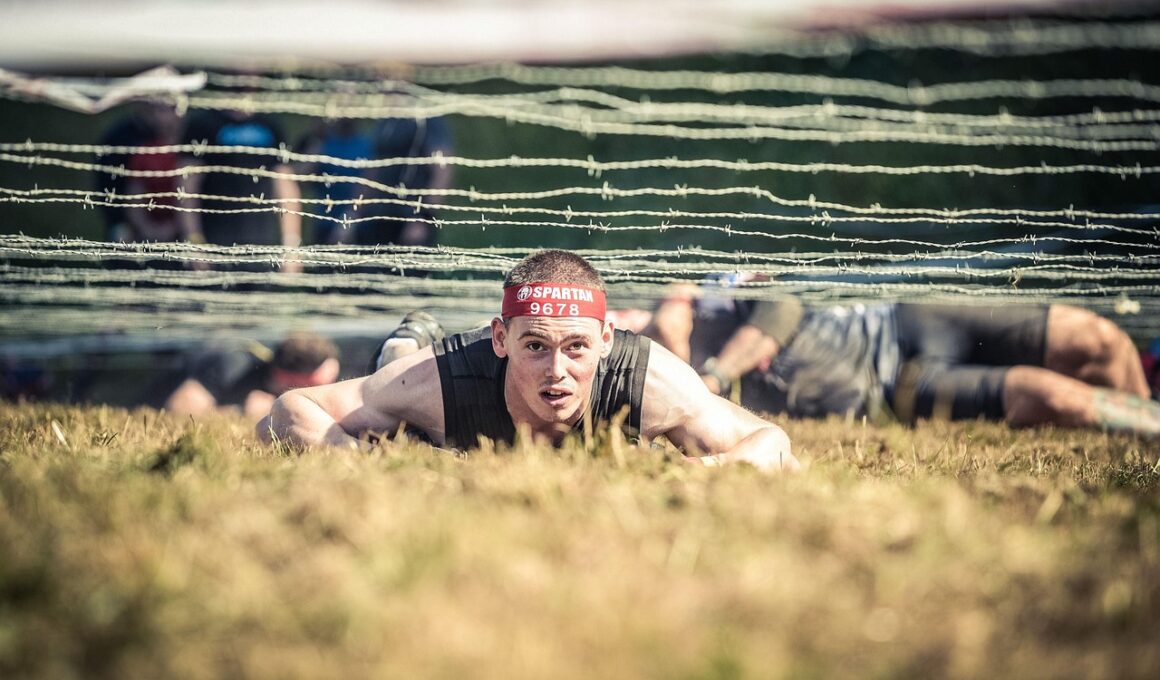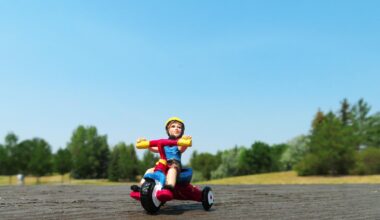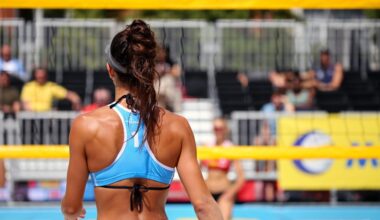The Role of Balance and Stability Exercises in OCR Cross-Training
Obstacle Course Racing (OCR) demands a unique blend of strength, agility, and endurance. Among these attributes, balance and stability are crucial for navigating various obstacles. Incorporating balance and stability exercises into cross-training regimens can significantly enhance an athlete’s performance. These exercises not only improve physical stability but also reduce the risk of injuries during races. Common exercises that boost balance include single-leg stands and stability ball workouts. Furthermore, plyometric drills, like box jumps, promote explosive stability, essential in OCR environments. Athletes can benefit from targeting core muscles as they play a fundamental role in maintaining overall balance. Stronger core muscles support movements during races and help stabilize the body during sudden direction changes. Additionally, practicing balance drills under dynamic conditions can effectively mimic race scenarios, improving adaptability and response time during obstacles. Engaging in outdoor activities, like trail running, integrates balance challenges into the training routine. Finally, consistent practice of these exercises ultimately enhances athletic performance and mental focus, crucial for any OCR competitor aiming for success.
The importance of stability in OCR is underscored by the unpredictable terrain athletes often face. As obstacles range from climbing walls to muddy courses, maintaining stability proves vital. Exercising in unstable environments, such as sand or uneven ground, builds resilience and improves proprioception. Proprioception refers to the body’s ability to sense its position in space, essential when maneuvering through diverse challenges. By enhancing proprioception, athletes become more adept at adjusting their movements quickly and accurately during races. Incorporating functional movement patterns in training can further enhance stability. Exercises that mimic race movements can help athletes react more instinctively. For instance, lateral lunges or agility ladder drills can optimize footwork and increase speed. Dynamic balance training, which involves practicing movements while in motion, further tests the body’s stability. Exercises like walking lunges or step-ups on a balance beam require focused balance and strength. Such training also engages the stabilizing muscles around joints, contributing to overall joint stability. Consequently, athletes who prioritize stability and balance training may notice improved performance on race day.
Benefits of Enhanced Balance in OCR
Enhanced balance contributes to superior performance during an OCR event. Athletes with good balance can navigate obstacles more efficiently, reducing race completion time. By mastering balance, athletes can conserve energy and maintain momentum through challenging sections. Another benefit of improved balance is the ability to make quick adjustments during races that involve lateral movements. This adaptability greatly minimizes the risk of falls or missteps that could cost valuable seconds. Moreover, athletes can handle uneven surfaces better when they have strong balance skills. Whether it’s running over logs or jumping across gaps, balance aids in overcoming these obstacles smoothly. Furthermore, training for balance often leads to greater body awareness. This heightened awareness helps athletes develop better movement patterns, leading to more efficient running styles. In competitive scenarios, body awareness can directly impact performance levels and race outcomes. Additionally, increased stability prevents injuries related to muscle strains or joint discomfort. Athletes who focus on balance and stability find themselves with fewer setbacks, allowing for a more effective and consistent training cycle. Hence, the advantages of mastering balance extend beyond just skill—promoting longevity in the sport.
Cross-training with balance exercises also promotes mental fortitude, essential for OCR athletes. As racers face physical challenges, maintaining mental clarity is paramount. Stability exercises often require concentration and focus, fostering mental resilience. As athletes improve their physical balance, they simultaneously enhance their mental strength. Training with a mindful approach supports better performance under pressure, a skill critical during competitive races. Incorporating yoga or Pilates into a training regimen can significantly contribute to stable mental health. These practices emphasize control, balance, and breathing techniques, promoting stability both physically and mentally. Furthermore, activities that challenge balance encourage athletes to escape their comfort zones. This resilience to discomfort translates directly into race situations, where quick thinking is vital. By facing balance challenges and overcoming them, athletes build confidence in their abilities. Sports like martial arts also focus on balance and agility, offering varied training methods to improve core strengths. Engaging in diverse balance-focused exercises can keep follow-through enthusiasm high while promoting holistic growth as an OCR athlete. Significantly, enduring balance challenges enhances overall athletic capability and ultimately aids in achieving personal bests in OCR events.
Integrating Balance and Stability into Training Routines
Integrating balance and stability exercises into existing training routines can greatly enhance an OCR athlete’s effectiveness. First, identifying specific balance challenges is crucial for beginning a focused training plan. Athletes can assess their strengths and weaknesses through various tests. Once identified, they can tailor exercises that target their individual needs. For instance, those struggling with dynamic movements may benefit from integrating reactive drills into their workouts. For example, balance boards or wobble discs introduce elements of instability. These tools can effectively enhance both balance and core strength. Gradually increasing workout difficulty can ensure improvements while minimizing injury risks. Mixing balance drills with strength training can maximize time spent in the gym. Athletes might incorporate exercises such as squat holds, balancing with weights, or lunges on foam pads. Creating a balanced week of training, ensuring ample focus on stability, rest, and recovery, can improve overall performance. Ultimately, a well-rounded approach to training fosters better race preparation, enabling athletes to approach obstacles confidently. Regularly dedicating time to stationary and dynamic balance exercises ensures sustained progression throughout their OCR journey.
Cross-training methods also play a pivotal role in strengthening balance and stability for OCR. Engaging in diverse sports enhances overall motor performance and challenges the body’s balance systems effectively. Cyclists often develop better core stability, which translates to improved performance in OCR. By cycling uphill or navigating rough terrains, they enhance both strength and balance without overloading joints. Swimming is another excellent cross-training option that boosts overall circulation while strengthening core muscles responsible for balance. Alternating between swimming and land workouts can add variety while promoting injury-free training. For instance, engaging in circuit training with balance elements ensures that athletes maintain a focus on stability during overall conditioning. Transitioning between disciplines can prepare the body for the varied challenges presented during OCR. Additionally, athletes can join group classes that focus on functional exercises. These classes often include balance-training components that may stimulate healthy competition among participants. Ultimately, trying out new activities expands an athlete’s skill set, enriching their balance capabilities. This holistic approach allows for more robust preparation before entering any OCR event, improving both physical ability and confidence.
The Future of Balance Training in OCR
As OCR continues to grow, the emphasis on balance training will likely expand substantially. Athletes and coaches will increasingly recognize the importance of integrating balance and stability exercises within their routines. Innovative training tools and methods will emerge, enhancing traditional approaches to balance training. Incorporating technology, such as virtual reality (VR), may provide unique training experiences focused on developing agility and spatial awareness. Furthermore, as OCR caters to a diverse range of fitness levels, accessible balance training will become paramount in programs and events. Strategies to incorporate balance-based exercises for beginners will benefit many aspiring OCR athletes. Developing simple, effective training programs that target balance at all entry levels will promote growth in the sport. Additionally, the role of nutrition in supporting balance training will receive more recognition. Proper nutrition boosts muscle recovery and enhances overall performance, which is essential for successful training environments. Consequently, as the understanding of balance’s role in OCR deepens, it will shape training philosophies. These innovations aim to maintain athlete enjoyment while fostering peak performance levels, ensuring OCR races remain exhilarating and rewarding experiences.
Ultimately, the fusion of balance and stability exercises into OCR cross-training is essential for cultivating adaptable, resilient athletes. The multifaceted challenges presented in OCR require utmost balance for optimal performance through difficult courses. By committing to a well-structured training regimen that emphasizes these skills, competitors can upscale both endurance and efficiency during races. Strong balance translates not only to athletic capability but also to personal confidence. As athletes master balance and stability, they cultivate greater mental toughness that influences their entire racing experience. In conclusion, OCR athletes should prioritize incorporating targeted balance training. This investment in preparation can pave the way for superior performance and an enhanced racing experience. The ability to effectively navigate obstacles is improved through persistent balance practice. Therefore, it is essential for athletes at all levels to understand the role of balance in their overall fitness journey. As OCR evolves, the commitment to balance training will remain a fundamental piece of athletic training philosophy, paving the road toward future athletic triumphs. Henceforth, OCR will become even more appealing to a wider range of fitness enthusiasts seeking challenging experiences that inspire growth and achievement.


